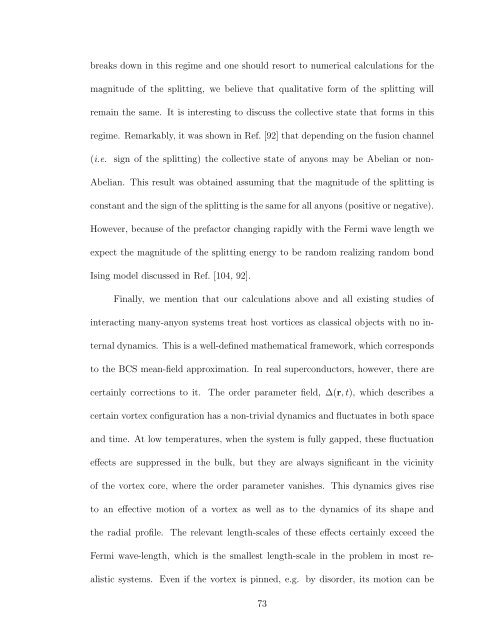ABSTRACT - DRUM - University of Maryland
ABSTRACT - DRUM - University of Maryland
ABSTRACT - DRUM - University of Maryland
You also want an ePaper? Increase the reach of your titles
YUMPU automatically turns print PDFs into web optimized ePapers that Google loves.
eaks down in this regime and one should resort to numerical calculations for the<br />
magnitude <strong>of</strong> the splitting, we believe that qualitative form <strong>of</strong> the splitting will<br />
remain the same. It is interesting to discuss the collective state that forms in this<br />
regime. Remarkably, it was shown in Ref. [92] that depending on the fusion channel<br />
(i.e. sign <strong>of</strong> the splitting) the collective state <strong>of</strong> anyons may be Abelian or non-<br />
Abelian. This result was obtained assuming that the magnitude <strong>of</strong> the splitting is<br />
constant and the sign <strong>of</strong> the splitting is the same for all anyons (positive or negative).<br />
However, because <strong>of</strong> the prefactor changing rapidly with the Fermi wave length we<br />
expect the magnitude <strong>of</strong> the splitting energy to be random realizing random bond<br />
Ising model discussed in Ref. [104, 92].<br />
Finally, we mention that our calculations above and all existing studies <strong>of</strong><br />
interacting many-anyon systems treat host vortices as classical objects with no internal<br />
dynamics. This is a well-defined mathematical framework, which corresponds<br />
to the BCS mean-field approximation. In real superconductors, however, there are<br />
certainly corrections to it.<br />
The order parameter field, ∆(r, t), which describes a<br />
certain vortex configuration has a non-trivial dynamics and fluctuates in both space<br />
and time. At low temperatures, when the system is fully gapped, these fluctuation<br />
effects are suppressed in the bulk, but they are always significant in the vicinity<br />
<strong>of</strong> the vortex core, where the order parameter vanishes. This dynamics gives rise<br />
to an effective motion <strong>of</strong> a vortex as well as to the dynamics <strong>of</strong> its shape and<br />
the radial pr<strong>of</strong>ile. The relevant length-scales <strong>of</strong> these effects certainly exceed the<br />
Fermi wave-length, which is the smallest length-scale in the problem in most realistic<br />
systems. Even if the vortex is pinned, e.g. by disorder, its motion can be<br />
73
















